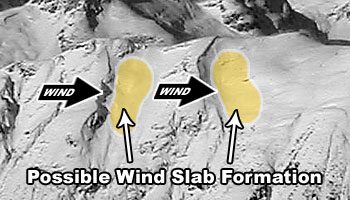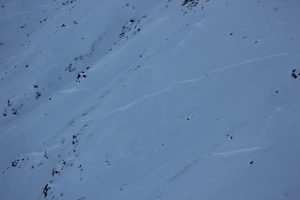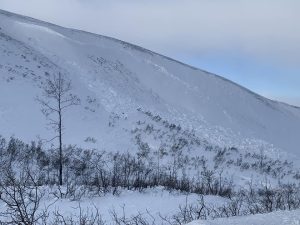Haines Avalanche Center
Above 2,500ftConsiderable
1,500 to 2,500ftModerate
Below 1,500ftLow
Degrees of Avalanche Danger
Avalanche Problems
Problem 1
The Bottom Line: Friday we are expecting to see increasing NW winds around 15mph, gusting to 30. This will cause the new snow to drift into fresh sensitive wind slabs 1-2ft thick which are likely to be triggered by a human (Especially in cross-loaded gullies, and also S and SE aspects). These surface wind slabs could also step down to rain crusts or the ground in particularly weak areas, causing deep and deadly avalanches.
Thoughts on Risk Reduction:
Let’s take a step back. We now have a few serious weak layers deep down in our snowpack that you do not want to trigger. Your best bet to avoid a deadly avalanche is to reign in your expectations and lower your risk tolerance. Keep a wider-than-usual margin of safety by sticking to low-angle terrain, and giving dangerous areas a wide berth. There will be times later this spring when you can be more ambitious with the terrain… this is not the time.
Midpack Melt Layers and Crusts:
There is a serious weak layer about 60cm deep (The “Big Warmup” Layer, Formed Nov 17th). It is a thick refrozen crust with weak facets above and below. With the low predictability of this unusual weak layer, a wide safety margin is necessary. Slides could propagate further than expected.
Observations from the Chilkat Pass zone on 12/4 found moderate strength but easy propagation on failures within this layer. We know it to exist at all elevations above 1000ft — even up to the highest summits. We expect this layer (or other midpack crust-facet layers) to be an ongoing issue going forward.
Depth Hoar Formation (Above 3000ft in the Lutak zone):
October snow followed by long cold snaps created depth hoar at the ground in most areas above treeline. As the snow gets deeper, the load over this weak layer increases, as does the likelihood that you could trigger a full-depth slide. This is becoming a high-consequence early-season snowpack that deserves respect and should drive conservative decision making. Even “small” slides could have large blocks of hard slab and bury a person quite deep in a terrain trap.
Snow pit photo from Lutak zone 12/1, and profile from 11/26.
Likelihood:
- Almost Certain
- Very Likely
- Likely
- Possible
- Unlikely
Size:
- Historic
- Very Large
- Large
- Small
Trend
- Increasing
- Steady
- Decreasing
Problem 2
Wind loaded slopes and cross-loaded gullies should be avoided. You can tell if a slope is wind loaded by the filled-in, or rounded shape of the snow. Probe around for hollow, slabby surface snow. Minimize your exposure to these slopes, and always travel one-at-a-time through any suspect areas. Rocks will be a major safety hazard as well, so take it slow and easy, and keep your avalanche eyeballs on, especially in wind loaded areas and convexities. Be careful to avoid terrain traps!
Likelihood:
- Almost Certain
- Very Likely
- Likely
- Possible
- Unlikely
Size:
- Historic
- Very Large
- Large
- Small
Trend
- Increasing
- Steady
- Decreasing
Avalanche Activity
Flower Mt. area, D2 wind slab near 4,000′ on E-NE aspects in cross loaded gullies and terrain features
Photo from 12/2 in the Transitional Zone Credit: Forecaster, Erik Stevens
(Click to enlarge)
We have had reports this week of natural D2 wind slab avalanches in cross loaded gullies.
Photo from 11/29 of a wind slab avalanche near 3 guardsmen, NE aspect at 3200ft, Credit: Dan Egolf
Weather
Forecast:
Friday will bring clearing skies. It looks like another cold clear weekend with increasing arctic outflow (moderate-strong NW winds). The next storm is likely by Monday evening.
Seasonal Summary:
- A storm on Dec 7th brought 17″ of snow to the Lutak zone and 7-10″ to the Transitional/Pass zones
- An arctic outbreak brought very cold temperatures and strong NW winds Nov 27-Dec 2nd
- Nov 20-25 brought about 2ft of new snow above 2000ft (about 1ft in the Pass zone)
- Mid November was very warm, with temperatures reaching over 40F at 5000ft
- Cold weather set in Nov 4th – 9th, with alpine temps down to 8F at times
- A NW wind event Nov. 6th blew away much of snow in exposed areas
- 2 to 3ft of snow fell in Early November down to sea level
- October 26-27th brought in 5-12″ of heavy wet snow above 1500ft
- The first layer of snow to remain into winter fell above 3,500ft on Oct 21st. It was 6-12″ deep.
| Snow Depth [in] | Last 24-hr Snow/SWE [in] | Last 3-days Snow/SWE [in] | Today’s Freezing Level [ft] | Today’s Winds | Next 24-hr Snow/SWE | |
| Mount Ripinsky @ 2,500′ | 58″ | 1″ / 0.10″* | 17″ / 1.50″* | 0′ | mod, NW | 0″ / 0.00″* |
| Flower Mountain @ 2,500′ | 35″ | 0″ / 0.00″ | 10″ / 1.00″ | 0′ | mod, NW | 0″ / 0.00″* |
| Chilkat Pass @ 3,100ft | 10″ | 0″ / 0.00” | 7″ / 0.33″ | 0′ | mod, NW | 0″ / 0.00″* |
( *star means meteorological estimate )
Additional Information
It’s time to start thinking avalanche. Dust off your gear and make sure it is fully functional. Put new batteries in your beacons! Do a beacon practice to start the season and keep your skills fresh.
If you head into the hills, watch out for avalanche prone areas, and be especially careful of rocks and hidden hazards like crevasses beneath the snow. WEAR A HELMET!
Announcements
Forecasts for the 2022/2023 winter season will be Fridays-Sundays. Click the Full Forecast link below to read more. Please submit your observations if you head out into the hills!






